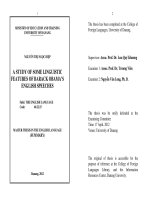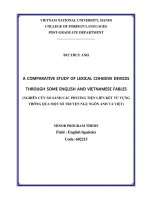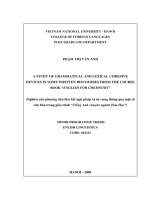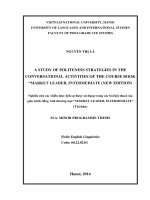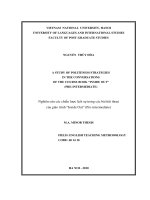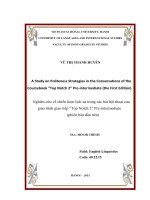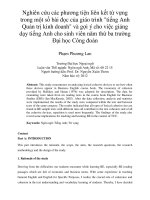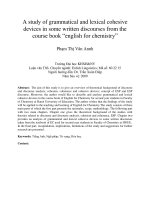A study on lexical cohesive devices from some reading texts of the course book English for Business Study and pedagogical implications for teaching English for third year students at Trade Union University
Bạn đang xem bản rút gọn của tài liệu. Xem và tải ngay bản đầy đủ của tài liệu tại đây (126.96 KB, 9 trang )
Nghiên cứu các phương tiện liên kết từ vựng
trong một số bài đọc của giáo trình "tiếng Anh
Quản trị kinh doanh" và gợi ý cho việc giảng
dạy tiếng Anh cho sinh viên năm thứ ba trường
Đại học Công đoàn
Phạm Phương Lan
Trường Đại học Ngoại ngữ
Luận văn ThS ngành: Ngôn ngữ Anh; Mã số: 60 22 15
Người hướng dẫn: Prof. Dr. Nguyễn Xuân Thơm
Năm bảo vệ: 2012
Abstract: This study concentrates on analyzing lexical cohesive devices to see how often
these devices appear in Business English course book. The taxonomy of cohesion
provided by Halliday and Hasan (1976) was adopted for description. The data for
examining were taken from six reading texts in the course book English for Business
Studies (EBS) (Ian MacKenzie, 2002). After the data collection, analysis and statistics
were implemented, the results of the study were compared within the text and between
texts of the same category. The results indicated that all types of lexical cohesive ties are
found in BE sample texts with different rates all contribute to the text cohesion; and of all
the cohesive devices, repetition is used most frequently. The findings of the study also
reveal some implications for teaching and learning BE in the context of TUU.
Keywords: Ngôn ngữ; Tiếng Anh; Từ vựng
Content
Part A: INTRODUCTION
This part introduces the rationale, the scope, the aims, the research questions, the research
methodology and the design of the study.
1. Rationale of the study
Deriving from the difficulties our students encounter while learning BE, especially BE reading
passages which are full of economic and business terms. With some experience in teaching
General English and English for Specific Purposes, I realize the crucial role of coherence and
cohesion in the text understanding and vocabulary learning of students. Thereby, I have decided
to conduct a research on lexical cohesive devices from some reading texts of the course book
English for Business Studies hoping that it may help students more in comprehending the
reading texts and learning vocabulary.
2. Aims of the study
In brief, the study would seek to answer the following questions:
1. What lexical cohesive devices are used in BE texts?
2. What lexical cohesive devices are employed most frequently in BE texts?
3. What are the overall features of BE discourses in terms of lexical cohesion?
3. Methods of the study
The study uses description, analysis and statistics research methods to achieve the research
objectives. The data for the research analysis are collected from six sample texts chosen in EBS
course book namely: Sample text 1: Types of banks; Sample text 2: Companies; Sample text 3:
Bonds; Sample text 4: Market leaders, challengers and followers; Sample text 5: Taxation;
Sample text 6: The business cycle. All the lexical cohesive items of each type of lexical cohesion
(reiteration and collocation) and its subtypes occur in the six texts are identified and calculated.
The total number of each type is then converted into percentage to compare within a text or
among the categories and according to the analytical purposes.
4. Significances of the study
This study provides an insight into the use of lexical cohesive devices in BE texts. Some
pedagogical implications are hopefully to be found in order to assist the writing and reading
comprehension of BE texts.
Part B: DEVELOPMENT
CHAPTER I: THEORETICAL BACKGROUND
This chapter addressed a review of literature related to concepts of discourse, text, discourse
analysis, discourse context, cohesion and coherence, cohesive devices which support this thesis.
In each section, the definition or explanation of the key terms is introduced.
1.1. Discourse and discourse analysis
1.1.1. Discourse
1.1. Discourse and discourse analysis
1.1.1. Discourse
1.1.2. Discourse and Text
1.1.3. Spoken and written discourse
1.1.4. Discourse Analysis
1.1.5. Discourse Context
1.1.5.1. Context
1.1.5.2. Context of situation
1.2. Cohesion and coherence
1.2.1. Cohesion
1.2.2. Coherence
1.2.3. Cohesion and coherence
1.3. Cohesive devices
1.3.1. Cohesive devices
1.3.2. Classification
1.3.2.1. Referential Cohesion
1.3.2.2. Substitution cohesion
1.3.2.3. Elliptical cohesion
1.3.2.4. Conjunctive cohesion
1.3.2.5. Lexical cohesion
1.3.2.5.1. Reiteration
1.3.2.5.2. Collocation
CHAPTER II: AN ANALYSIS OF LEXICAL COHESIVE DEVICES IN BE READING
TEXTS IN THE COURSE BOOK EBS
In this chapter, the collected data was analyzed and discussed, the findings of the study
also answer to the three research questioned raised in the Introduction part
2.1. An overview of the study
This part is devoted to presenting the methodology of the research, including the data collection
instruments and procedure and data analysis.
The subjects of the study
The six texts studied in this thesis are extracted from six units of the course book EBS
which are included in the ESP course level 2, the course designed for third year students at TUU.
This course book was chosen as the main material for teaching and learning ESP of almost all
the faculties at TUU. Most of the units in the course book contain three components:
1. An informative reading text giving an overview of a particular topic
2. Either listening exercises or shorter authentic reading passage.
3. An additional case study, role play, discussion activity or writing exercise.
The six sample texts are taken from the first part of each unit. They aim at introducing
key business and economic concepts, including a large amount of relevant economic terms. They
are chosen to be examined because of having high frequent occurrence of lexical cohesive ties.
The following table presents the origin of each sample text:
Text
Unit
Sample text 1: Types of bank
Unit 14: Banking
Sample text 2: Companies
Unit 15: Stock and shares
Sample text 3: Bonds
Unit 16: Bonds
Sample text 4: Market leaders, challengers
and followers
Unit 18: Market structure and competition
Sample text 5: Taxation (and how to avoid
it!)
Unit 23: Central banking, money and
taxation
Sample text 6: The business cycle
Unit 25: The business cycle
Data analysis methods
The examination of all cohesive ties appeared in the six texts is implemented in the following
steps:
Step 1: each type of cohesive devices is taken into consideration, in particular, the author
search for every lexical item related to the examined device in all the texts, then calculate them
and sum up.
Step 2: the absolute count of each category is then converted to the percentage for
comparison.
Step 3: the count and percentage of each type and sub-type of cohesive devices are
grouped in categories and according to the analytical purpose of the study.
2.2. Analysis of lexical cohesive devices in BE reading texts
In this section, collected data was analyzed and discussed, the findings of the study answer to the
three research questions raised in the Introduction part. Specifically, each type of lexical
cohesion is examined carefully to see how frequently they appear and why they are used in BE
texts, i.e. how these devices help students comprehend the texts.
2.2.1. Reiteration
2.2.1.1. Repetition
2.2.1.1.1. Simple repetition
2.2.1.1.2. Complex repetition
2.2.1.2. Synonyms and near synonyms
2.2.1.3. Antonymy
2.2.1.4. Superordinates
2.2.2. Collocation
2.2.3. Summary
Major findings will be summarized and some pedagogical implications will be presented in the
next part – CONCLUSION.
Part C: CONCLUSION
The conclusion part shows a recapitulation of the study, implications for teaching and learning
BE. This section also discusses the limitations of the study as well as some recommendations for
further research.
1. Major findings of the research
The aims of the study include investigating the kinds of lexical cohesive device and their
frequency of occurrence in EBS text book and providing an insight into the use of these lexical
cohesive devices thereby hopefully assisting the learning and teaching of BE.
The findings of the research reveal that all the types of lexical cohesion: reiteration,
including repetition, synonymy, antonymy, superordinate; and collocation are common in BE
texts of which repetition appears with the highest frequency.
The research findings also reveal that some overall features of BE discourses regarding
lexical cohesion are identified such as: in BE texts, lexical cohesive devices are used to create a
high cohesiveness of the discourses. The text is therefore coherent for readers. The facts that
repetition is used dominantly and that nouns and noun phrases are the most common cases of
simple repetition enable readers to identify the topic of the text more easily. In BE texts,
synonymy is employed as a cohesive device to express meanings differently and therefore, avoid
unnecessary repetitions. In BE texts, the fact that the majority of synonyms identified falls under
the categories of nouns and verbs shows that, one of the linguistic features of BE texts which is
determined by the particular purpose of it is introducing key economic terms and clarifying
business and economic concepts. Similarly, the use of antonyms in BE texts help explain the
terms and notions more easily by observing the contrary relations among word pairs, emerging
the main idea of each paragraph and the topic of the whole text. Hence, it makes the text more
comprehensible for readers. The fact that BE texts includes numerous generalizations of business
and economic concepts has explained why relational antonyms are used more frequently than
contrary antonyms. Super-ordinate and collocation are effective ways to create connections
among words, phrases, paragraphs and the whole BE text. They link words and ideas of a BE
text in a logical way therefore create coherence and thus comprehensibility of the text. In other
words, the more related lexical items are used the more cohesiveness of the text they create.
2. Pedagogical implications
The above concluding remarks also imply some suggestions for the teaching and learning
of the reading and writing activities in BE as follows:
In exploiting collocation in BE reading and writing activities, teachers should set up
learning tasks such as:
- identify the possibility of the co-occur tendency of some certain words in BE
discourses,
- find the topic of the reading texts through the elicited sequence of related words,
- make use of collocations in reading text to write a passage which is cohesive and
coherent,
- summarize the paragraph or the whole text using given collocations,
- translate the passage into the source language.
It should be noted that during translating task students should be aware of collocations, in
particular, the meaning of a collocation should be taken into account instead of the
dictionary meaning of the individual words. This therefore dissuade them from word-by-
word translating or mistranslating.
For learners, collocation also helps them greatly in learning vocabulary. Particularly, new
vocabulary can be more easily remembered when it is learned in its context, i.e. in collocation
relations. As a result, new vocabulary can be recalled at any time and retained in learners for a
long time. In addition, learners should be encouraged to use dictionary of collocation especially
when they do writing and translating tasks. Hence, collocation helps enlarge the vocabulary of
students.
In exploiting repetition device, teachers may ask students to elicit the most repeated items
in the whole text to guess the topic of it. This helps students greatly in interpreting the
text.
3. Limitations and Suggestions for further studies
Although the study has done, it is unavoidable that there are some limitations of the
research due to the limited scope, the time constraint and other objective factors. It is also
regrettable that small number of sample texts may not help create the most valid analytical
results.
Future researches can shed some light on:
Other cohesive devices such as: grammatical, topical and logical cohesion of BE written
discourses to improve the teaching and learning of BE.
Evaluating the affects of cohesive devices knowledge on the students' abilities in learning
writing and reading BE discourses.
The causes of common errors made by BE learners when using cohesive devices to create
and interpret BE discourses and solutions for it.
References
1. Brown, G. & G. Yule (1983) Discourse Analysis. Cambridge: CUP.
2. Crystal, D. (1992) Introducing Linguistics. London: Penguin
3. Eggins, S. (1994) An Introduction to Systematic Functional Linguistics. London -
Continuum
4. Halliday, M.A.K (1994), An Introduction to Functional Grammar, 2nd edition, London:
Edward Arnold
5. Halliday, M.A.K & Hasan, R. (1976) Cohesion in English. London: Longman
6. Hasan, R. (1984) Coherence and Cohesive Harmony. London: Longman
7. Hoa, N. (2000), An Introduction to Discourse Analysis, Vietnam National University
Press.
8. Hoa, N. (2004) Understanding English Semantics, Vietnam National University Press.
9. Hoey, M. (1991) Patterns of Lexis in Text. Oxford: Oxford University Press
10. Ian MacKenzie (2002) English for Business Studies. Cambridge: Cambridge University
Press
11. Nunan, D. (1993) Introducing Discourse Analysis. London: Penguin English.
12. Oxford Advanced Learner's Dictionary (2000). Oxford University Press.
13. Oxford Collocation Dictionary (2002). Oxford: Oxford University Press.
14. Palmer, J. A. (1983b) Getting into Text: Coherence in Cross Currents X2.
15. Salkie, R. (1995) Text and Discourse Analysis. London: Routledge
16. Tanskanen, S. (1984) Collaborating towards Coherence. John Benjamins Publishing
Company.
17. Thompson, G. (1996) Introducing Functional Grammar. New York: Oxford University
Press
18.Van, H. V. (2006) Introducing Discourse Analysis. Hanoi: Educational Publishing House
